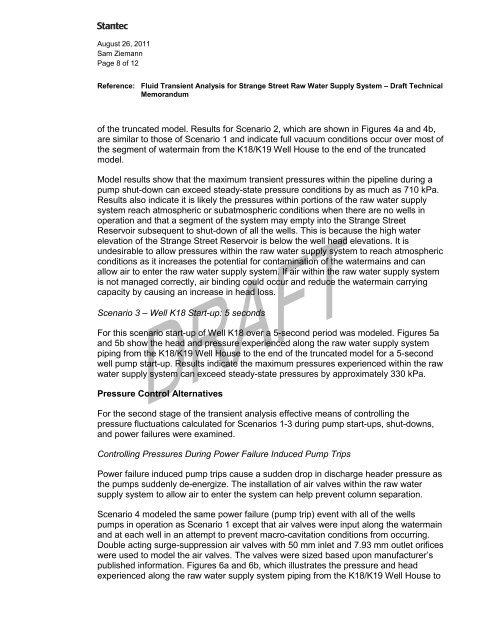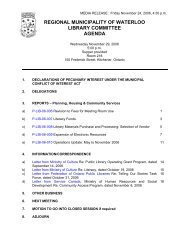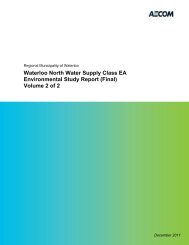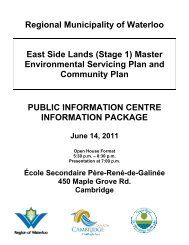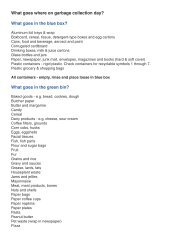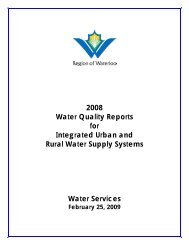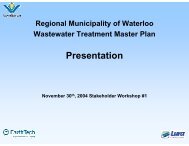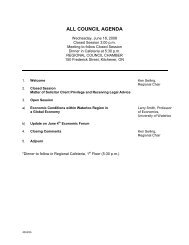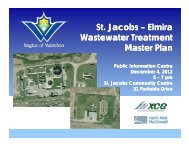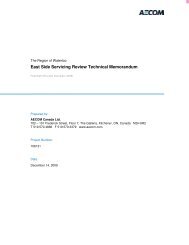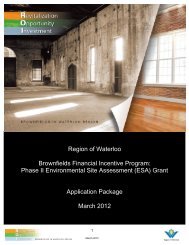Sam Ziemann From - Region of Waterloo
Sam Ziemann From - Region of Waterloo
Sam Ziemann From - Region of Waterloo
Create successful ePaper yourself
Turn your PDF publications into a flip-book with our unique Google optimized e-Paper software.
August 26, 2011<strong>Sam</strong> <strong>Ziemann</strong>Page 8 <strong>of</strong> 12Reference: Fluid Transient Analysis for Strange Street Raw Water Supply System – Draft TechnicalMemorandum<strong>of</strong> the truncated model. Results for Scenario 2, which are shown in Figures 4a and 4b,are similar to those <strong>of</strong> Scenario 1 and indicate full vacuum conditions occur over most <strong>of</strong>the segment <strong>of</strong> watermain from the K18/K19 Well House to the end <strong>of</strong> the truncatedmodel.Model results show that the maximum transient pressures within the pipeline during apump shut-down can exceed steady-state pressure conditions by as much as 710 kPa.Results also indicate it is likely the pressures within portions <strong>of</strong> the raw water supplysystem reach atmospheric or subatmospheric conditions when there are no wells inoperation and that a segment <strong>of</strong> the system may empty into the Strange StreetReservoir subsequent to shut-down <strong>of</strong> all the wells. This is because the high waterelevation <strong>of</strong> the Strange Street Reservoir is below the well head elevations. It isundesirable to allow pressures within the raw water supply system to reach atmosphericconditions as it increases the potential for contamination <strong>of</strong> the watermains and canallow air to enter the raw water supply system. If air within the raw water supply systemis not managed correctly, air binding could occur and reduce the watermain carryingcapacity by causing an increase in head loss.Scenario 3 – Well K18 Start-up: 5 secondsFor this scenario start-up <strong>of</strong> Well K18 over a 5-second period was modeled. Figures 5aand 5b show the head and pressure experienced along the raw water supply systempiping from the K18/K19 Well House to the end <strong>of</strong> the truncated model for a 5-secondwell pump start-up. Results indicate the maximum pressures experienced within the rawwater supply system can exceed steady-state pressures by approximately 330 kPa.Pressure Control AlternativesFor the second stage <strong>of</strong> the transient analysis effective means <strong>of</strong> controlling thepressure fluctuations calculated for Scenarios 1-3 during pump start-ups, shut-downs,and power failures were examined.Controlling Pressures During Power Failure Induced Pump TripsPower failure induced pump trips cause a sudden drop in discharge header pressure asthe pumps suddenly de-energize. The installation <strong>of</strong> air valves within the raw watersupply system to allow air to enter the system can help prevent column separation.Scenario 4 modeled the same power failure (pump trip) event with all <strong>of</strong> the wellspumps in operation as Scenario 1 except that air valves were input along the watermainand at each well in an attempt to prevent macro-cavitation conditions from occurring.Double acting surge-suppression air valves with 50 mm inlet and 7.93 mm outlet orificeswere used to model the air valves. The valves were sized based upon manufacturer’spublished information. Figures 6a and 6b, which illustrates the pressure and headexperienced along the raw water supply system piping from the K18/K19 Well House to


